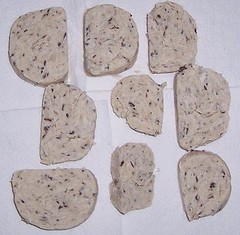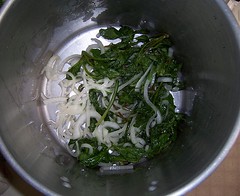
Little soft taco-sized numbers, and so easy to make:
- 2 cups all-purpose, unbleached white flour
- 1/2 teaspoon salt
- 1/4 cup palm shortening (original recipe calls for lard)
- 1 tablespoon canola oil
- 1/2 cup warm water
Mix together the flour and salt, then cut in the shortening with your hands until the mixture resembles course crumbs. Add the water and oil and knead into a smooth dough. Divide evenly into 16 balls of dough and let sit in the fridge for at least one hour. Heat a skillet (mine is plain old stainless and works fine, but seasoned cast iron is supposed to be ideal) to just below medium. Roll out the dough as thinly as possible. I roll mine between two pieces of non-stick parchment paper so additional flour isn't necessary. Carefully lay the tortilla in the pan and cook until the surface begins to puff (you can see this just starting in the pic above). Turn over and cook for a few more seconds. Repeat with the rest of the dough.
And today, in my never-ending quest to find new things to ferment, I'm attempting homemade soy sauce. Well, bean sauce, anyway. I'm using black-eyed peas instead of soy. Following the directions I found here, I made the flour/bean loaf:

After ten days under layers of paper towel, they should be well-inoculated with the necessary microorganisms, and hopefully the weather will have cheered enough to dry them outside. After that, it's a summer's worth of fermenting until it's ready to bottle and use. So much for instant gratification.
